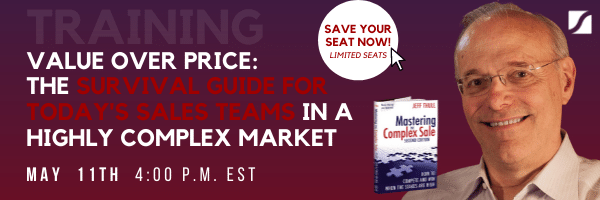How to Gain Exceptional Credibility Through Exceptional Sales Conversations

Credibility and trust are the building blocks of complex sales. They are critical elements, essential to closing any deal.
As a salesperson, what’s your strategy for establishing the credibility necessary for prospects to trust you in guiding them toward the most valuable solution to their problem?
We asked around. Most salespeople responded, “We tell them.”
But telling customers about your high-level credibility isn’t ideal. Your accolades and your company’s background fall flat when such information comes from you. Instead, you must enable the customer to realize it through your sales conversations.
Before we share how you can do that, let’s look at the two types of credibility:
- Expected credibility includes a proven track record, a list of satisfied customers, your number of years in business, and the company’s financial strength, business size, etc. Expected credibility is just that: What customers expect vendors to have. But, if every competitor has similar credibility, what differentiates you in the eyes of your customer?
- That’s where exceptional credibility comes in. Exceptional credibility is what you know about your customer, their individual job responsibilities, business objectives, performance, and challenges. The best way to develop exceptional credibility is through diligent preparation and thought-provoking questions.
Yes, that’s right: The best way to establish exceptional credibility is through the questions you ask—not the stories you tell.
In a traditional sales approach, the salesperson asks a few questions to qualify a customer (“Do you use our product in your process?”), conducts a superficial needs analysis (“Are you using software to manage that product?”), makes a presentation listing the top assets their solution provides, and quickly arrives at the “close” (“When can we implement a trial run?”).
However, this fast-paced approach doesn’t accomplish what is necessary for the customer to identify and desire the most appropriate solution. Without delving deeply into the customer’s situation, the standard approach relies on customers to self-diagnose and (hopefully!) connect your high-value solution to their problem.
Most salespeople under-prepare and ask too few questions, which leaves the door open for you. You have the opportunity to ask the thought-provoking questions that will differentiate you and your company.
Three Levels of Sales Questions
There are three levels of questions salespeople ask customers:
- Level one: Personal questions about customer demographics. Salespeople want personal facts about customers so they can “relate.” Nothing wrong there, unless it’s as far as the conversation goes. Also, as a best practice, never ask a question you could find the answer to elsewhere.
- Level two: “Opinion”-type questions designed to collect information from the customer, such as “What are your concerns regarding ...?” or “What’s keeping you awake at night?” These standard questions gather the customer’s opinion about their problem, what they think the solution should be, when they may make a decision, and how much money they plan to invest.
Opinion-type questions don’t expand the customer’s knowledge of the problem, their view of the solution, or your credibility. While far better than level one, they’re very limiting if you stop there and even more limiting if you assume the customer’s opinion represents a complete understanding of their situation. - Level three: Observational questions that expand the customer’s understanding of their problem and the optimal way to solve it. These detailed, diagnostic-type questions are the building blocks of exceptional credibility. We expect no less from other professionals we rely on for their expertise – such as doctors or lawyers.
Surprisingly, what would be considered malpractice in medicine and law is an all-too-often standard operating procedure in sales. We not only let customers diagnose their own problems, but we also encourage them to do so by asking “opinion-level” questions.
To move the diagnostic process toward revealing and clarifying the customer’s problem, you need to drill deeper with third-level, observational questions.
How Opinion And Observational Questions Differ
Here’s the difference between opinion-level and observational questions:
Opinion-level questions: “Are you happy with your production numbers?” or “Are you satisfied with the current performance of your (product)?” These questions ask the customer to render their opinion based on an implicit self-diagnosis.
Observation-level questions: “How many unscheduled shutdowns have you experienced during the past two years?” This calls for an empirical observation. When the customer reveals how many times they’ve shut down, that fact represents a problem which needs to be addressed. After such a revelation, it’s a short path to helping the customer realize their problem requires a solution—your solution.
The key takeaway here is that opinion-level questions often generate “we’re satisfied” answers. Conversely, observational questions allow sales professionals to access facts relevant to a 360-degree diagnosis of the customer’s situation. The answers to observational questions point conversations in new directions and allow you to become a problem-solver for your customers.
The Role of Privileged Access And Privileged Insight
So, how can you level-up your questions? And, how do you determine whom to ask once you’ve elevated them?
Authentic and compelling customer conversations are the key to what I call “privileged access” and “privileged insight.”
Privileged access is necessary to tap into the best sources of information within your customers’ organizations.
Privileged insight is what you need to clearly understand your customers, their responsibilities and metrics, and thus discover how you can impact their objectives. It is the only way you can create compelling value, and it is the reason customers will understand and embrace that value.
Why You Must Become An Expert Diagnostician
Many sales professionals leap before all facts are gathered and propose solutions that lack relevance in the customer’s mind. A core competency of the complex sale is the ability to perform as an expert diagnostician.
In short, there are two reasons customers will not act on a proposal:
- They don’t believe they have the problem, or that it is large enough to take action.
- They don’t believe the solution will work, and they won’t receive the value promised.
Reason number one is by far the more frequently given, which tells us that using diagnostic conversations to reveal the scope of the problem and the financial benefit of your solution are the key to increasing complex sales.
Diagnostic expertise enables us to help customers more clearly recognize, analyze, and understand the causes and consequences of their situation. These conversations are fact-finding missions. The focus is on the physical symptoms — the customer’s reality — rather than what the customer believes the solution to be. The goal is to raise the customer’s awareness of the problems they are experiencing.
Equally important, diagnosing allows you to shift the emphasis of your conversations with customers from your solutions to their situations
This shift differentiates you from competitors, creates significant learning for the customer, and builds exceptional credibility. Customers often make the decision to invest in your solution during the diagnosis.
4 Ways Self-Diagnosis Is Sales Malpractice
Needs-based selling assumes—falsely—that customers can correctly self-diagnose their problem and self-prescribe the solution.
Self-diagnosis is one of the most significant contributors to lack of clarity in the sales process. Here are four reasons why:
- Customers often misdiagnose their problems before and during the sales process. Without a thorough diagnostic conversation, the seller will often prescribe an ineffective solution, which leads to solution failure with all of its negative consequences.
- Self-diagnosis represents a missed opportunity for sales professionals to demonstrate their expertise by taking the diagnosis to depths of the problems and risks the customer would never have considered. It’s a tremendous missed opportunity to differentiate your solution from the competition.
- Customers miss their chance to get an “outside view” from professionals who have likely dealt with similar situations in other companies.
- The total cost of the problem is not established because self-diagnosis is a less-than-comprehensive process. Therefore, the ability to construct a compelling business case for the solution is severely restricted.
The best sales professionals are skilled integrators: They orchestrate the many separate pieces needed to solve customers’ problems in novel and intriguing ways.
They achieve this through a structured series of diagnostic conversations in which you communicate with customers at a mutually higher level of understanding.
The goal is to become so good at diagnosing complex problems that the style and substance of your conversations create all the credibility and relevance you need to win customers’ confidence and, ultimately, their business.
The Diagnostic Conversation
The diagnostic conversation has three primary objectives:
- Uncover the reality of the customer’s problem (Do the symptoms exist?)
- Quantify the impact of the problem; the absence of the solution (How bad is it?)
- Create the “Incentive to Change” (Is it bad enough to take action?)
As you move through diagnostic conversations, remember that you gain more credibility from the questions you ask than the stories you tell.
Asking the customer to fill in the blanks of your diagnostic sales script is a powerful interaction that engages them to discover the extent of the challenge they’re facing and the value of the solution you’re offering.
The diagnostic conversation itself is very straightforward. Sales professionals must repeat it with key players from various functional areas in order to uncover the full spectrum of the customer’s problem.
Whether the situation requires ten or dozens of conversations, pursue them all until you have uncovered every facet of the problem and established a credible, compelling portrait of the business impact.
The Diagnostic Conversation Format
Diagnostic conversations uncover what’s happening, how bad it is, and whether it’s serious enough to act upon. No matter how many times you repeat it, there is one basic format for the diagnostic conversation:
- Connections. Uncovering the individual’s job responsibility and determining how the problem impacts their area makes your diagnosis relevant.
- Indicators. Physical symptoms — evidence of the condition that is placing the individual’s job performance at risk — tell you and your customer what’s happening.
- Consequences. Determining the problem’s impact on the business and its severity tells you what and who is being affected and provides a means to quantify the financial impact.
- Priority. Establishing the problem’s position relative to other issues the customer is facing tells you whether and when the problem is worth resolving.
All businesses measure their performance in dollars and cents. Therefore, any problem they are experiencing or opportunity they are missing can and must be expressed in financial terms.
If there isn’t a cost of the problem, there isn’t a tangible problem.
Until you quantify the impact, you are dealing with a highly speculative issue that can derail with the slightest distraction.
Quantifying The Value Of Your Solution
The most significant component of a compelling diagnostic conversation is the quantification of value. I refer to it as the cost of the problem.
By defining the cost of the problem, you simultaneously put a price tag on the customer’s dissatisfaction and determine your solution’s value. The higher the cost of the problem, the greater the pressure to solve it, and the quicker the decision to solve it will be made.
Calculating the cost of the problem isn’t necessarily easy, which is why it’s so valuable.
The calculation doesn’t have to be precise; it just needs to be believed by your customer. In other words, there’s wiggle room, but the figure must be close, and your method must be credible.
Calculating costs is similar to navigating via triangulation. By sighting off of three points—the direct numbers, indirect numbers, and lost opportunities—you can arrive at a credible cost.
To do so, first, develop a conceptually sound formula. Second, be sure that the numbers plugged into that formula are derived from your customer’s current reality, not past numbers or industry averages.
Your formula’s objective is to enable the customer to recognize its validity and its lack of vendor bias. Customers are immune to most ROI tools sellers use. They must clearly see that inputting their data into your formula will provide an accurate measurement of their current situation.
Why Diagnostic Conversations Close Deals
The fundamental concept of the diagnostic conversation is that the questions are relevant to the customer.
Answering them increases the customer’s understanding of a situation that is critical to their performance objectives. Each succeeding question provides additional relevancy and clarity, increasing the customer’s desire to continue providing information that will lead to further clarity.
The diagnostic conversation is exceptionally customer-centric. As such, it is recognizably different from the majority of needs-based sales techniques. Diagnostic conversations set your company apart from your competition.
Your customers will grant you privileged access and insight, fueling your ability to create credible and compelling solutions. By establishing an accurate cost of the problem, you essentially determine the value of your solution. Amazing things happen to timetables, priorities, and perceived value once the customer truly understands the cost of their problem.
The next-level engagement of the diagnostic sales conversation imbues you with credibility and trust while it provides customers with a quality decision process. As a result, you win more sales!




